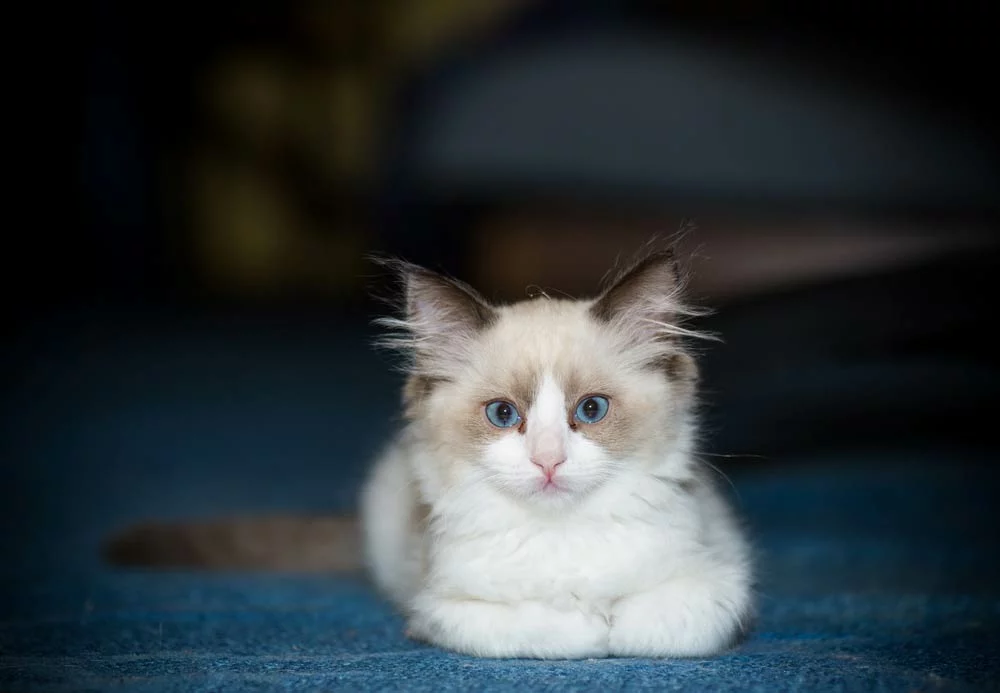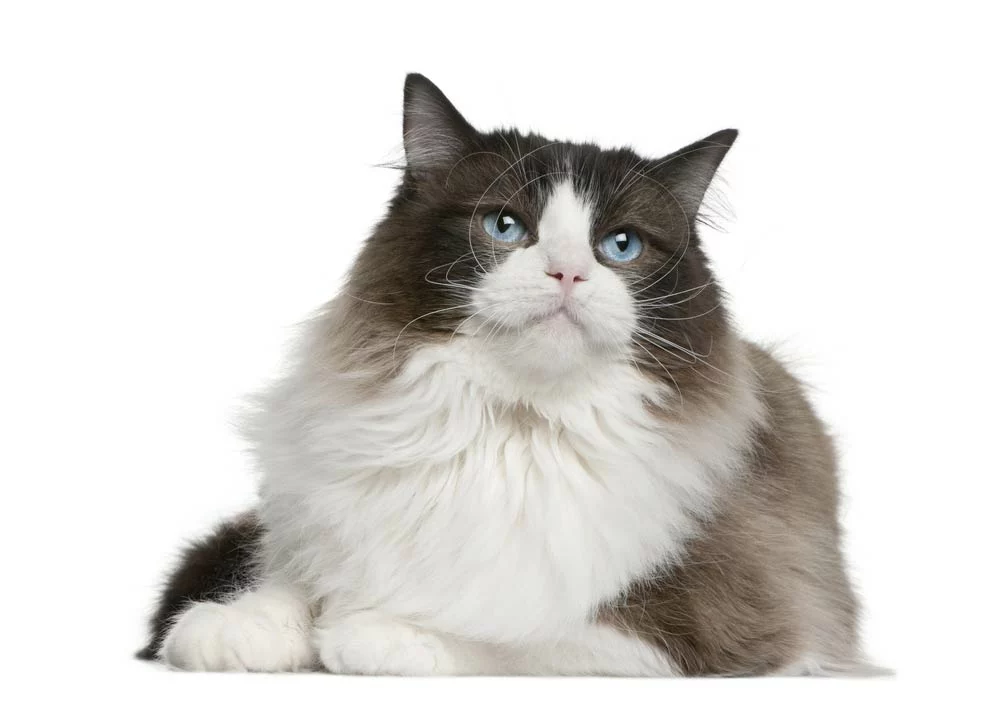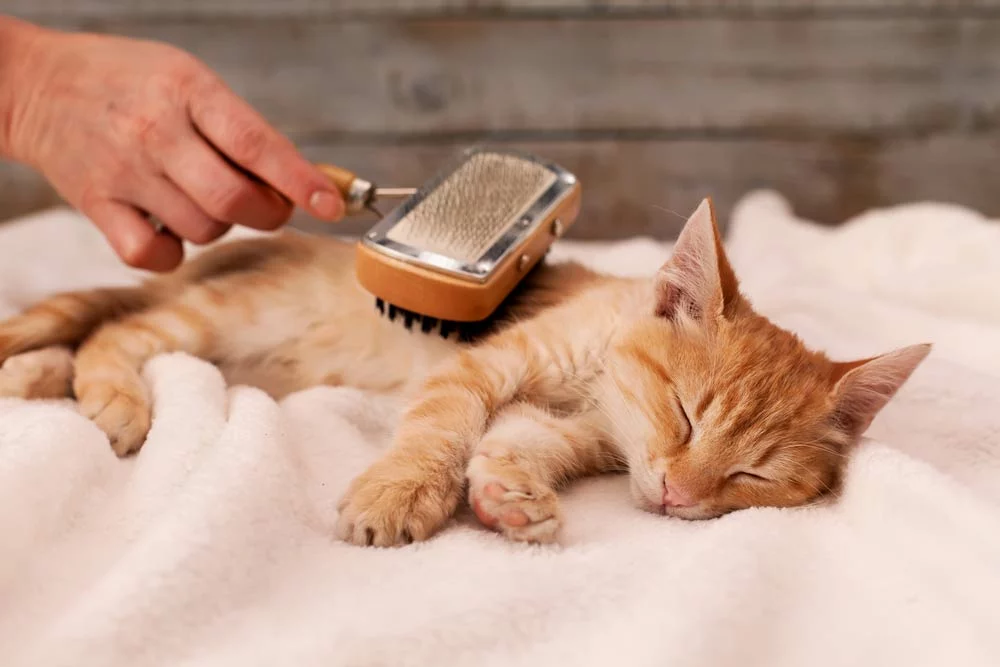The Ragdoll cat types is famous for its semi-long-haired silky coats, calm temperament, and friendly personality. Generally, Ragdolls have an almost puppy-like attachment to their owners. They also have a habit of going limp like rag dolls in the arms of anyone who picks them up.
But do you know that Ragdolls come in six distinct colors? Today, we are going through all Ragdoll cat types and how you can differentiate between them.
Table of Contents
The Basics of the Coat

(A Ragdoll cat)
The Himalayan Gene
The Himalayan gene controls a Ragdoll’s color and body pattern based on body temperature.
That means the gene blocks the color from developing if a particular area has a high temperature. When the temperature lowers or is at normal body temperature, it allows the color to develop. It’s okay if your Ragdoll has a slightly different coloring in the winter and summer.
Ragdoll Cat Types

(Two-month-old Ragdoll kitten at home)
Here’s a look at the major Ragdoll coat types.
Colorpoint Coats
Whereas the seal is the most popular color for Ragdolls, colorpoint is the most known patterning. Colorpoint refers to a different coat coloring on a Ragdoll’s extremities or “pointed areas” like ears, head, muzzle, tail, and paws. Like the Bengals, the cat doesn’t have solid colors, spots, or strips. Instead, it has a light-colored body, either white or cream, with a darker face, ears, limbs, and tail.
Studies attribute Ragdolls’ point pattern to heat exposure during kittenhood and their unique genetic coding. Because of the warmth in their mother’s womb, Ragdoll kittens are born nearly white. As they grow, their point gene responds to the temperature of their immediate surroundings and begins to develop a shaded color.
Their extremities are darker due to how blood circulation works—the middle body receives more blood flow and develops a brighter hue. On the other hand, the edge points develop to a darker shade due to less blood flow. And that is why Ragdolls’ coat colors tend to vary in the summer and winter or when they have poor circulation.
Bicolor Coats

(Ragdoll cat sitting in front of white background)
A bicolor Ragdoll’s white spotted muzzle (resembling a white mask) lends a lovely and childish appearance. Bicolor Ragdolls often have a lighter underbody with spotting on their upper torso, tail, and legs. A true bicolor is characterized genetically by a dominant white spotting gene.
Also, the excellent partition of light and dark sections of the body lends this cat an undeniable attractiveness.
Mitted Coats
The Mitted Ragdoll cat has a close resemblance to the colorpoint. However, it differentiates itself by having white ‘gloves’ on the front paws and ‘booties’ on the back paws. But It doesn’t mean that all cats with “mitted” patterns are Ragdolls.
To be termed mitted, your Ragdoll must have a complete white belly stripe running from the bib through the forelegs. Furthermore, true Mitted Ragdolls may have a white spot on their face that looks like a blaze, star, or hourglass.
Lynx Coats
Ragdolls with lynx coats have a colorpoint, mitted, or bicolor pattern combined with a tabby (stripes) pattern. The stripes are the same color as the cat’s primary color.
A lynx Ragdoll has a reddish-to-pink nose and no color inside the ears. The nose outline’s color is the same as the points, and the forehead stripes form an M-shaped mark. The mark is more or less apparent depending on whether or not white is present on the face.
Except for the Bicolor cats, which have white legs, the legs and tails of other lynx ragdolls have rings. Additionally, the area of the patterns around the nostrils and the hair within the ears are all broken white.
Tortoiseshell (or Tortie) Coats

(A tortoiseshell coat cat)
Tortie is an acronym for Tortoiseshell, as the coat resembles a tortoise’s speckled shell. The Tortie Ragdoll cat’s coat mixes two colors other than white, either closely blended or in wider areas. Their points are mottled with black (seal or chocolate) and red pigment (red or cream). And they’re a unique type as Ragdoll tortoiseshell cats are usually female. The males are very rare and born sterile.
Do Ragdolls Need a Type-Specific Care Regime?
(A playful Ragdoll cat eating)
And the good news is that all Ragdolls have the same upkeep regime. Pay close attention to your cat’s grooming needs and nutrition if you have one.
Grooming Needs

(Young kittens enjoy fur brushing)
Ragdolls are quite simple to care for. Specifically, they require the same routine veterinary care, proper diet, and dental hygiene as all cats. Proper Ragdoll care also includes bathing the feline at least once monthly to remove loose fur or dead skin.
Nutrition
Ragdolls require a high-protein meat diet to maintain their enormous frame. According to nutritionists, a Ragdoll’s meal should mimic the dietary profile of a normal feline diet. It should have over 50 percent animal protein, 20 percent fat, and, at most, 3 percent carbohydrates. Overconsumption of carbohydrates can easily cause obesity and diabetes in Ragdolls.
Conclusion
We all love Ragdolls’ unique ability to change coat color depending on ambient temperature conditions. And what’s even better is that each Ragdoll cat has a beautiful coat and a friendly personality.
Finally, many Ragdoll cats prefer to avoid great heights, unlike others. Consequently, don’t strain to buy towering cat trees with perches.
